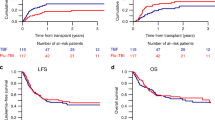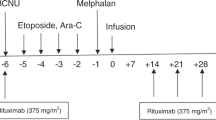Abstract
The purpose of the study was to evaluate in patients with recurrent intermediate-grade NHL, the tolerance to and efficacy of an intensive salvage regimen consisting of high doses of ifosfamide, etoposide and mitoxantrone with G-CSF support, followed by autologous stem cell transplantation and to identify prognostic factors for survival in patients with recurrent aggressive lymphoma. Patients with recurrent intermediate-grade NHL under the age of 60 years were eligible. Induction consisted of ifosfamide 10 g/m2 and etoposide 900 mg/m2 with G-CSF 5 μg/kg twice a day. Upon recovery, patients underwent stem cell apheresis. Patients achieving complete remission (CR) underwent autologous stem cell transplantation using BEAM conditioning. Those with partial remission (PR) received treatment with ifosfamide 10 g/m2, mitoxantrone 20 mg/m2 and G-CSF 5 μg/kg. Those with CR received BEAM, those with PR received cyclophosphamide 4.5 g/m2, etoposide 1200 mg/m2 and cisplatin 135 mg/m2 with stem cell rescue followed by BEAM. Antibiotic prophylaxis was given with all treatment cycles. The results were compared with those obtained in a prior study that used MINE-ESHAP salvage. Forty-four patients with recurrent intermediate-grade NHL were enrolled between March 1994 and September 1996. Median age was 50 years (24–61). Eleven patients had transformed lymphoma and seven had a T cell phenotype. Response rate to the high-dose ifosfamide regimen was 77% ± 12% after two cycles and the complete response rate was 41% ± 14%. Myelosuppression was profound but short. Median nadir ANC was 0 and the median duration of ANC <0.5 × 109/l was 6 days (range 3–12). No severe infections occurred; 55% of the patients required blood transfusion and 42% required platelet transfusions. Myelosuppression and transfusion requirements were similar after the first and second cycles. Thirty-five of the 44 patients proceeded to autologous stem cell transplantation and one transplant-related death occurred. With a median follow-up of 52 months, progression-free survival at 2 years is 38% ± 14% and survival is 52% ± 15%. Data from these 44 patients were pooled with data on 53 patients who had received salvage treatment with MINE-ESHAP, for a multivariate analysis of prognostic factors. In multivariate analysis, serum LDH was strongly associated with survival. The use of a more intensive salvage regimen, did not result in a significant increase in long-term outcome, despite a high response rate. In conclusion, duration of treatment, response rates, treatment-related mortality and survival compare favorably with previous salvage regimens, but recurrence remains a major problem. Long-term survival in recurrent large cell lymphoma is influenced more by disease characteristics than by the type of salvage regimen used. Bone Marrow Transplantation (2001) 27, 397–404.
This is a preview of subscription content, access via your institution
Access options
Subscribe to this journal
Receive 12 print issues and online access
$259.00 per year
only $21.58 per issue
Buy this article
- Purchase on Springer Link
- Instant access to full article PDF
Prices may be subject to local taxes which are calculated during checkout




Similar content being viewed by others
References
Velasquez WS, McLaughlin P, Tucker S et al. ESHAP–an effective chemotherapy regimen in refractory and relapsing lymphoma: a 4 year follow-up study J Clin Oncol 1994 12: 1169–1176
Rodriguez MA, Cabanillas FC, Velasquez W et al. Results of a salvage treatment program for relapsing lymphoma: MINE consolidated with ESHAP J Clin Oncol 1995 13: 1734–1741
Philip T, Guglielmi C, Hagenbeek A et al. Autologous bone marrow transplantation as compared with salvage chemotherapy in relapses of chemotherapy-sensitive non-Hodgkin's lymphoma New Engl J Med 1995 333: 1540–1545
Blay J-Y, Gomez F, Sebban C et al. The international prognostic index correlates to survival in patients with aggressive lymphomas in relapse: analysis of the PARMA trial Blood 1998 92: 3562–3568
Rodriguez MA, van Besien K, Swan F et al. MINE-ESHAP-BEAC: an induction consolidation program for relapsed intermediate grade lymphoma ASCO Proc 1995 14: 397
Van Besien KW, Tabocoff J, Rodriguez MA et al. Intensive chemotherapy with the BEAC regimen and autologous bone marrow transplantation in patients with refractory or recurrent intermediate grade and immunoblastic lymphoma; toxicity, long-term follow-up and identification of prognostic factors Bone Marrow Transplant 1995 15: 549–555
Meloni G, Capria S, Proia A et al. Ice pops to prevent melphalan induced stomatitis Lancet 1996 347: 1691–1692
Bearman SI, Appelbaum FR, Buckner CD et al. Regimen-related toxicity in patients undergoing bone marrow transplantation J Clin Oncol 1988 6: 1562–1568
Van Besien K, Rodriguez M, Amin K et al. Intensive reinduction with high-dose ifosfamide/VP16 and ifosfamide/novantrone followed by BEAM and stem cell transplant for patients with recurrent lymphoma ASCO Proc 1997 16: 21a
Shimamoto Y, Pichyangkul S, Khan A . Enhancement of cell-mediated cytotoxicity by recombinant tumor necrosis factor (TNFα) Proc Soc Exp Biol Med 1988 189: 310–316
Altman DG . Analysis of survival times Practical Statistics for Medical Research Chapman and Hall, London 1991 365–395
Cox DR . Regression models and life tables (with discussions) J Roy Stat Soc (Series B) 1972 34: 187–220
Przepiorka D, Nath R, Ippoliti C et al. A phase I–II study of high-dose thiotepa, busulfan and cyclophosphamide as a preparative regimen for autologous transplantation for malignant lymphoma Leuk Lymphoma 1995 17: 427–433
Rodriguez MA, Swan F, Hagemeister F et al. Sequential intense dose chemotherapy and peripheral stem cell support in refractory lymphoma ASCO Proc 1994 13: 1320
Meyer RM, Hryniuk WM, Goodyear MDE . The role of dose intensity in determining outcome in intermediate-grade non-Hodgkin's lymphoma J Clin Oncol 1991 9: 339–347
Johansen MJ, Madden T, Mehra RC et al. Phase I pharmacokinetic study of multicycle high-dose carboplatin followed by peripheral-blood stem cell infusion in patients with cancer J Clin Oncol 1997 15: 1481–1491
Hudis C, Fornier M, Riccio L et al. 5-Year results of dose-intensive sequential adjuvant chemotherapy for women with high-risk node-positive breast cancer: a phase II study J Clin Oncol 1999 17: 1118–1126
Pott C, Tiemann M, Linke B et al. Structure of Bcl-1 and IgH-CDR3 rearrangements as clonal markers in mantle cell lymphomas Leukemia 1998 12: 1630–1637
Moskowitz CH, Bertino JR, Glassman JR et al. Ifosfamide, carboplatin, and etoposide: a highly effective cytoreduction and peripheral-blood progenitor-cell mobilization regimen for transplant-eligible patients with non-Hodgkin's lymphoma J Clin Oncol 1999 17: 3776–3785
Bodey GP et al. Quantitative relationships between circulating leukocytes and infections in patients with acute leukemia Ann Int Med 1966 61: 328–340
Donato M, Champlin R, van Besien K et al. Intensive dose ifosfamide and etoposide with G-CSF for stem cell mobilization in patients with non-Hodgkin's lymphoma Leuk Lymphoma 1999 35: 317–324
Demirer T, Buckner CD, Storer B et al. Effect of different chemotherapy regimens on peripheral-blood stem-cell collections in patients with breast cancer receiving granulocyte colony-stimulating factor J Clin Oncol 1997 15: 684–690
Aurlien E, Holte H, Pharo A et al. Combination chemotherapy with mitoguazon, ifosfamide, MTX, etoposide (MIME) and G-CSF can efficiently mobilize PBPC in patients with Hodgkin's and non-Hodgkin's lymphoma Bone Marrow Transplant 1998 21: 873–878
McQuaker IG, Haynes AP, Stainer C et al. Stem cell mobilization in resistant or relapsed lymphoma: superior yield of progenitor cells following a salvage regimen comprising ifosphamide, etoposide and epirubicin compared to intermediate-dose cyclophosphamide Br J Haematol 1997 98: 228–233
Johnson PW, Sweetenham JW, McCallum P et al. E-SHAP, inadequate treatment for poor prognosis recurrent lymphoma Ann Oncol 1993 4: 63–67
Moskowitz CH, Nimer SD, Glassman J et al. The international prognostic index predicts for outcome following autologous stem cell transplantation in patients with relapsed and primary refractory intermediate-grade lymphoma Bone Marrow Transplant 1999 23: 561–567
Guglielmi C, Gomez F, Philip T et al. Time to relapse has prognostic value in patients with aggressive lymphoma enrolled on to the Parma trial J Clin Oncol 1998 16: 3264–3269
Guglielmi C, Martelli M, Federico M et al. Risk-assessment in diffuse large cell lymphoma at first relapse. A study of the Italian intergroup for lymphomas Ann Oncol 1999 10: (Suppl. 3) (Abstr. 183)
Melnyk A, Rodriguez A, Pugh WC, Cabannillas F . Evaluation of the Revised European-American Lymphoma classification confirms the clinical relevance of immunophenotype in 560 cases of aggressive non-Hodgkin's lymphoma Blood 1997 89: 4514–4520
Gisselbrecht C, Gaulard P, Lepage E et al. Prognostic significance of T-cell phenotype in aggressive non-Hodgkin's lymphomas. Groupe d'Etudes des Lymphomes de l'Adulte (GELA) Blood 1998 92: 76–82
Stamatoullas A, Fruchart C, Bastit D et al. Ifosfamide, etoposide, cytarabine, and methotrexate as salvage chemotherapy in relapsed or refractory aggressive non-Hodgkin's lymphoma Cancer 1996 77: 2302–2307
Stamatoullas A, Fruchart C, Khalfallah S et al. Peripheral blood stem cell transplantation for relapsed or refractory aggressive lymphoma in patients over 60 years of age Bone Marrow Transplant 1997 19: 31–35
Baars JW, Holtkamp MJ, Nooyen WJ et al. Mobilisation of blood progenitor cells with ifosfamide and etoposide (VP-16) in combination with recombinant human G-CSF (Filgrastim) in patients with malignant lymphomas or solid tumours Anticancer Res 1996 16: 3089–3095
Garay G, Dupont J, Dragosky M et al. Combination salvage chemotherapy with MIZE (ifosfamide-mesna, idarubicin and etoposide) for relapsing or refractory lymphoma Leuk Lymphoma 1997 26: 595–602
McQuaker I, Haynes A, Stainer C et al. Mobilisation of peripheral blood stem cells with IVE and G-CSF improves CD34+ cell yields and engraftment in patients with non-Hodgkin's lymphomas and Hodgkin's disease Bone Marrow Transplant 1999 24: 715–722
Ribrag V, Nasr F, Bouhris JH et al. VIP (etoposide, ifosfamide and cisplatinum) as a salvage intensification program in relapsed or refractory Hodgkin's disease Bone Marrow Transplant 1998 21: 969–974
Bonfante V, Viviani S, Santoro A et al. Ifosfamide and vinorelbine: an active regimen for patients with relapsed or refractory Hodgkin's disease Br J Haematol 1998 103: 533–535
Haim N, Ben Shahar M, Faraggi D et al. Dexamethasone, etoposide, ifosfamide, and cisplatin as second-line therapy in patients with aggressive non-Hodgkin's lymphoma Cancer 1997 80: 1989–1996
Haim N, Drumea K, Epelbaum R, Ben Shahar M . Dexamethasone, cytarabine, ifosfamide, and cisplatin as salvage therapy in non-Hodgkin lymphoma Am J Clin Oncol 1999 22: 47–50
Mayer J, Koristek Z, Vasova I et al. Ifosfamide and etoposide-based chemotherapy as salvage and mobilizing regimens for poor prognosis lymphoma Bone Marrow Transplant 1999 23: 413–419
McBride NC, Ward MC, Mills MJ et al. Epic as an effective, low toxicity salvage therapy for patients with poor risk lymphoma prior to beam high dose chemotherapy and peripheral blood progenitor cell transplantation Leuk Lymphoma 1999 35: 339–345
Lopez R, Martino R, Brunet S et al. Salvage chemotherapy with IAPVP-16 for advanced refractory or relapsed follicular lymphomas Haematol 1999 84: 911–916
Anselmo AP, Meloni G, Cavalieri E et al. Conventional salvage chemotherapy vs high-dose therapy with autografting for recurrent or refractory Hodgkin's disease patients Ann Hematol 2000 79: 79–82
Salar A, Martino R, Altes A et al. High-dose ifosfamide and etoposide infusion plus methylprednisolone for refractory or relapsed aggressive non-Hodgkin's lymphoma Haematol 2000 85: 217–219
Author information
Authors and Affiliations
Rights and permissions
About this article
Cite this article
van Besien, K., Rodriguez, A., Tomany, S. et al. Phase II study of a high-dose ifosfamide-based chemotherapy regimen with growth factor rescue in recurrent aggressive NHL. High response rates and limited toxicity, but limited impact on long-term survival. Bone Marrow Transplant 27, 397–404 (2001). https://doi.org/10.1038/sj.bmt.1702793
Received:
Accepted:
Published:
Issue Date:
DOI: https://doi.org/10.1038/sj.bmt.1702793
Keywords
This article is cited by
-
Management of relapsed diffuse large B-cell lymphoma
Current Oncology Reports (2008)
-
Clinical activity of arsenic trioxide in Burkitt-like lymphoma
Leukemia (2003)



